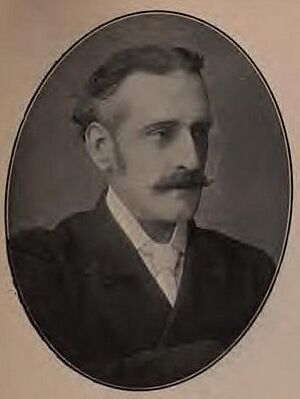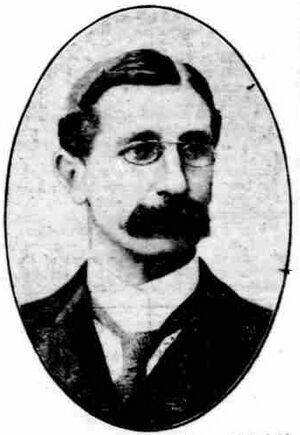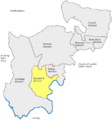Brentford (UK Parliament constituency) facts for kids
Quick facts for kids {{{Name}}}[[{{{Type}}} constituency]] |
|
|---|---|
| [[Image:{{{Map1}}}Constituency.svg|120px|]] [[Image:England{{{Map2}}}.svg|120px|]] |
|
| {{{Name}}} shown within [[{{{Entity}}}]], and {{{Entity}}} shown within England | |
| Created: | {{{Year}}} |
| MP: | {{{MP}}} |
| Party: | {{{Party}}} |
| Type: | House of Commons |
| County: | [[{{{County}}}]] |
| EP constituency: | [[{{{EP}}} (European Parliament constituency)|{{{EP}}}]] |
Brentford was an important area, or "constituency," in the United Kingdom. It was named after the town of Brentford in Middlesex. This area included places like Hounslow, Norwood Green, and Twickenham.
From 1885 to 1918, people living in Brentford voted for one person to represent them. This person was called a Member of Parliament (MP). MPs work in the House of Commons, which is part of the UK Parliament. The Brentford constituency was created for the 1885 United Kingdom general election and stopped being a constituency after the 1918 United Kingdom general election.
Contents
Understanding Brentford's Area
Where Was the Brentford Constituency?
The Brentford constituency covered the local area of Brentford. It also included the towns of Heston, Isleworth, Norwood (also known as Norwood Green), and Twickenham. Part of Hanwell was also included.
This area was in the southwest part of Middlesex. Today, this is in outer southwest London. Brentford was one of seven similar areas in Middlesex. It was named after its old market town, Brentford, which is on the north side of the River Thames.
The Brentford constituency was next to other voting areas. To the north and northeast was Ealing. To the southeast was Kingston. From the northwest to the southwest, it bordered Uxbridge.
How the Area Changed Over Time
Before 1885, Brentford was a key voting spot for the larger Middlesex county. In 1885, many new constituencies were created across the country. Middlesex went from having 18 MPs to 47 MPs. This was a very big change!
After 1918, the Brentford constituency was replaced. Its areas became parts of two new constituencies. These were Brentford and Chiswick and Twickenham.
Today, the land that was once the Brentford constituency is part of modern London. It is now split between the London Borough of Hounslow, London Borough of Richmond upon Thames, and London Borough of Ealing.
People Who Represented Brentford (MPs)
An MP is a person elected by the people in a constituency. They speak for their area in Parliament. Here are the MPs who represented Brentford:
| Year | Member | Party | |
|---|---|---|---|
| 1885 | Octavius Coope | Conservative | |
| 1886 | James Bigwood | Conservative | |
| 1906 | Vickerman Rutherford | Liberal | |
| 1910 | Lord Alwyne Compton | Conservative | |
| 1911 | William Joynson-Hicks | Conservative | |
| 1918 | constituency abolished | ||
Election Results in Brentford
Elections are how people choose their MPs. Here's a look at some of the elections in Brentford.
Elections in the 1880s
In the 1885 United Kingdom general election, Octavius Coope won for the Conservative Party. He received 3,563 votes. The Liberal candidate, James Haysman, got 2,267 votes.
After Coope passed away, a special election was held. This is called a "by-election." In the 1886 Brentford by-election, James Bigwood won for the Conservatives. He got 2,572 votes. James Haysman, the Liberal candidate, got 1,316 votes.
Elections in the 1890s
In the 1892 United Kingdom general election, James Bigwood was re-elected. He won with 4,417 votes for the Conservative Party. His opponent, Harry Heldmann from the Liberal Party, received 2,625 votes.
In the 1895 United Kingdom general election, James Bigwood won again. This time, he was the only candidate. This means he was elected "unopposed."
Elections in the 1900s
In the 1900 United Kingdom general election, James Bigwood was once more elected unopposed. He continued to represent Brentford for the Conservative Party.
The 1906 United Kingdom general election saw a change! Vickerman Rutherford won for the Liberal Party. He received 6,506 votes. The long-serving Conservative MP, James Bigwood, got 6,053 votes. This was a big win for the Liberals.
Elections in the 1910s
In the January 1910 United Kingdom general election, the Conservatives won back the seat. Lord Alwyne Compton became the new MP. He received 10,675 votes. The Liberal MP, Vickerman Rutherford, got 6,819 votes.
Later that year, in the December 1910 United Kingdom general election, Lord Alwyne Compton won again. He secured 9,199 votes for the Conservative Party. The Liberal candidate, William George Lobjoit, received 6,124 votes.
In the 1911 Brentford by-election, another special election was held. William Joynson-Hicks won for the Conservative Party. He was elected unopposed, meaning no other candidates ran against him.
The next general election was expected in 1914 or 1915. Before it could happen, World War I began. The candidates ready to run were William Joynson-Hicks for the Unionists (Conservatives) and William George Lobjoit for the Liberals. However, the election did not take place due to the war. The Brentford constituency was then abolished in 1918.
Images for kids




